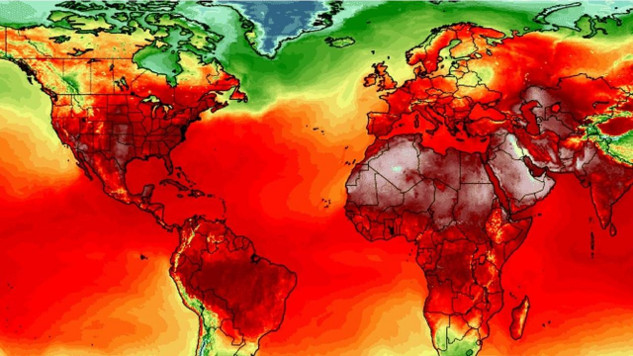
In this Article:
- How did Canada’s June 2024 heat wave set new records?
- What is climate attribution, and how does it link heat waves to climate change?
- How can the ECCC’s findings help prepare for future extreme weather events?
- What are the specific risks of heat waves for vulnerable populations?
- Why is real-time climate attribution crucial for adapting to a warming world?
How Climate Change Fueled Canada’s June Heat Wave
by Gordon McBean, Western University.
This June saw major heat waves across Canada with peak temperatures — measured over a three-day period — of 7.4 C in eastern Ontario, 10.7 C in southern Québec, 7.2 C in northern Québec and 10.6 C in Atlantic Canada. On June 19, more than 100 locations across Canada set new heat records for that day, with Bathurst, N.B., being the hottest at 37.6 C. The year 2023 was the globally hottest year on record.
The 2021 Intergovernmental Panel on Climate Change Assessment Report states: “Human activities, principally through emissions of greenhouse gases, have unequivocally caused global warming” and that “human-caused climate change is already affecting many weather and climate extremes in every region across the globe.”
However, just what are the scientific, policy and societal links between the June 2024 heat waves and climate change? Was the heat wave just a normal climatic variation, or something which can be attributed to human-caused climate change?
For the first time Environment and Climate Change Canada (ECCC) has drawn a clear link between heat waves and climate change using this June heat wave as a key data set. These findings, and how they were made, have the potential to fundamentally shift how we best adapt to a warming world.
Finding attribution
The ECCC’s Rapid Extreme Event Attribution system is designed to examine the links between human-caused climate change and the increased risk of heat waves and extreme cold and precipitation events. However, attribution is not an easy task.
The ECCC uses robust climate models to simulate both the “climate of the 1800s, based on levels of atmospheric gases that existed before the Industrial Revolution” and the climate of today with present greenhouse gas concentrations. Comparing these two models allows researchers to understand how climate change “has changed the chances of such a heat wave occurring” from the 1800s to the present day.
This system allows near-instant attribution in the event of extreme weather events. Indeed, the European research group World Weather Attribution has said that “Canada appears to be the first nation to commit to doing so on an ongoing basis.”
The ECCC attribution analyses for the June 2024 heat waves concludes that “the event was made much more likely by the human influence on the climate.” It is clear evidence of the connections between climate change and extreme weather events.
A report on the attribution of the June heat wave to climate change produced by Global News.
By learning how much human-caused climate change affects extreme weather events, the ECCC will enable better preparation for changing weather patterns while also aiding adaptation efforts.
Actions to prepare Canadians for extreme weather events, like heat, and taking the best steps to reduce their climate vulnerability will only become more important in the coming decades. The impacts of climate change will be felt by all, however extreme heat has a particularly acute impact upon those aged 65 and older and those who work in the service sector.
Addressing the impacts
Over the past 12 months, human-caused climate change added, on average, 26 more days of extreme heat across the globe, according to an International Federation of Red Cross and Red Crescent Societies report. It is further estimated that 6.8 billion people experienced at least 31 days of extreme heat, with tens of thousands of people dying. The real number may be much higher, because unlike sudden “event” weather disasters, heat waves kill more slowly and less obviously, depending on pre-existing health conditions. Extreme heat can also affect mental health.
The European Court of Human Rights confirmed that climate change is intimately linked to human rights. Moreover, the court also ruled that all European governments are accountable to adopt more rigorous measures to combat climate change, and that citizens have a right to sue their governments to hold them to account.
Climate change is impacting every aspect of human life and the risks will continue to grow with increasing frequency and severity. A 2021 synthesis report on Building Climate Resilient Communities shows that, while some communities in Canada have prepared high level adaptation plans, very few have detailed implementation strategies with established funding frameworks and Canada is lagging in climate change adaptation.
The climate crisis needs to be reviewed from all perspectives, including that of social scientists. The attribution program can help provide needed information in real time, which will help the public and climate experts design and implement more effective action.![]()
Gordon McBean, Professor Emeritus, Department of Geography and Environment, Western University
Article Recap
Canada’s record-breaking June 2024 heat wave has been directly linked to human-caused climate change, according to new findings from the ECCC. Using advanced climate models, scientists demonstrated that this heat wave was made significantly more likely by global warming. As extreme weather events become more common, understanding these links will help inform public policy and adaptation strategies, ensuring better preparation for future heat waves and minimizing the risks, particularly for vulnerable populations.
This article is republished from The Conversation under a Creative Commons license. Read the original article.
Related Books
Climate Adaptation Finance and Investment in California
by Jesse M. Keenan This book serves as a guide for local governments and private enterprises as they navigate the unchartered waters of investing in climate change adaptation and resilience. This book serves not only as a resource guide for identifying potential funding sources but also as a roadmap for asset management and public finance processes. It highlights practical synergies between funding mechanisms, as well as the conflicts that may arise between varying interests and strategies. While the main focus of this work is on the State of California, this book offers broader insights for how states, local governments and private enterprises can take those critical first steps in investing in society’s collective adaptation to climate change. Available On Amazon
This book serves as a guide for local governments and private enterprises as they navigate the unchartered waters of investing in climate change adaptation and resilience. This book serves not only as a resource guide for identifying potential funding sources but also as a roadmap for asset management and public finance processes. It highlights practical synergies between funding mechanisms, as well as the conflicts that may arise between varying interests and strategies. While the main focus of this work is on the State of California, this book offers broader insights for how states, local governments and private enterprises can take those critical first steps in investing in society’s collective adaptation to climate change. Available On Amazon
Nature-Based Solutions to Climate Change Adaptation in Urban Areas: Linkages between Science, Policy and Practice
by Nadja Kabisch, Horst Korn, Jutta Stadler, Aletta Bonn This open access book brings together research findings and experiences from science, policy and practice to highlight and debate the importance of nature-based solutions to climate change adaptation in urban areas. Emphasis is given to the potential of nature-based approaches to create multiple-benefits for society.
This open access book brings together research findings and experiences from science, policy and practice to highlight and debate the importance of nature-based solutions to climate change adaptation in urban areas. Emphasis is given to the potential of nature-based approaches to create multiple-benefits for society.
The expert contributions present recommendations for creating synergies between ongoing policy processes, scientific programmes and practical implementation of climate change and nature conservation measures in global urban areas. Available On Amazon
A Critical Approach to Climate Change Adaptation: Discourses, Policies and Practices
by Silja Klepp, Libertad Chavez-Rodriguez This edited volume brings together critical research on climate change adaptation discourses, policies, and practices from a multi-disciplinary perspective. Drawing on examples from countries including Colombia, Mexico, Canada, Germany, Russia, Tanzania, Indonesia, and the Pacific Islands, the chapters describe how adaptation measures are interpreted, transformed, and implemented at grassroots level and how these measures are changing or interfering with power relations, legal pluralismm and local (ecological) knowledge. As a whole, the book challenges established perspectives of climate change adaptation by taking into account issues of cultural diversity, environmental justicem and human rights, as well as feminist or intersectional approaches. This innovative approach allows for analyses of the new configurations of knowledge and power that are evolving in the name of climate change adaptation. Available On Amazon
This edited volume brings together critical research on climate change adaptation discourses, policies, and practices from a multi-disciplinary perspective. Drawing on examples from countries including Colombia, Mexico, Canada, Germany, Russia, Tanzania, Indonesia, and the Pacific Islands, the chapters describe how adaptation measures are interpreted, transformed, and implemented at grassroots level and how these measures are changing or interfering with power relations, legal pluralismm and local (ecological) knowledge. As a whole, the book challenges established perspectives of climate change adaptation by taking into account issues of cultural diversity, environmental justicem and human rights, as well as feminist or intersectional approaches. This innovative approach allows for analyses of the new configurations of knowledge and power that are evolving in the name of climate change adaptation. Available On Amazon
From The Publisher:
Purchases on Amazon go to defray the cost of bringing you InnerSelf.comelf.com, MightyNatural.com, and ClimateImpactNews.com at no cost and without advertisers that track your browsing habits. Even if you click on a link but don't buy these selected products, anything else you buy in that same visit on Amazon pays us a small commission. There is no additional cost to you, so please contribute to the effort. You can also use this link to use to Amazon at any time so you can help support our efforts.


























